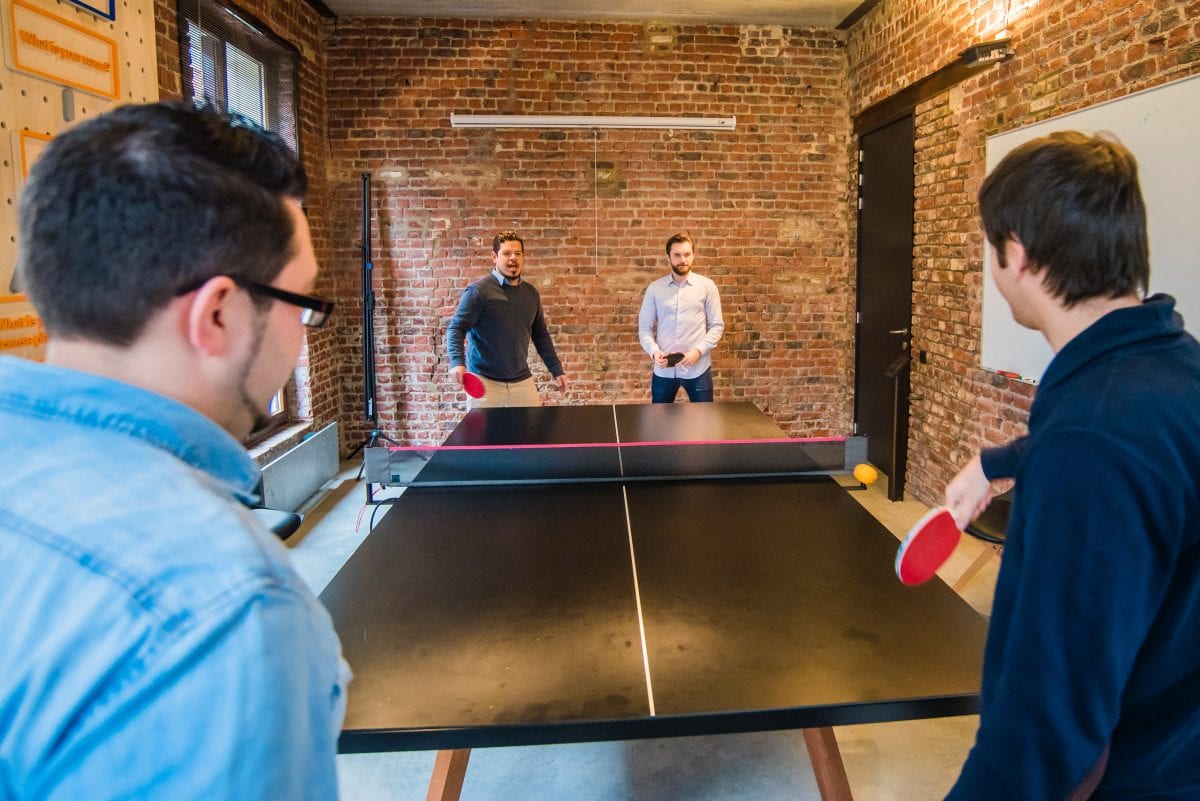
Ping-pong, foosball, and hammocks—these are just a few of the fun amenities that companies are providing to employees. Can an employee have fun at work while staying productive? Are these features just a cool trend or do they have a measurable impact on productivity? These interactive elements can improve talent retention and employee morale, but only if they align with business values.
The Workplace as a Social Hub
Silicon Valley was one of the first sectors to embrace the open office. It has the dual advantage of promoting collaboration while reducing real estate costs. It seemed like a smart move to place twice as many people in an open floor than individual cubicles. But many companies have found that the success of an open layout depends entirely on their workplace culture.
It’s the same way with “fun” workplaces. The intention is to transform the office into a place where employees can socialize. I’ve seen everything from arcade tables and gaming consoles to movie theaters with real popcorn. Some organizations encourage people to hop on scooters as a novel way to get to meetings. I even know a company that has a library with a gas fireplace.
But is a big slide really the right choice for your company? These features aren’t always all fun and games. For starters, you need a certain amount of available space. And then there’s your workplace culture, which may not give employees the freedom to let go of their professional decorum.
Plus, a fun amenity always runs the risk of turning into a distraction. For example, a bean bag toss won’t make a difference if employees don’t feel like they have permission to use it. That’s because a fun workplace isn’t the result of your amenities—it’s the atmosphere you create around them.
If one fun amenity doesn’t fit your workplace culture, there may be others that do. A lobby slide may not fit your organization, but there are myriad ways to turn your workplace into a strategic advantage.
Four Rules for Fun Workplaces
Your workplace is one of the most strategic parts of your organization. If you want to offer amenities that lighten the mood, you have to be intentional. Here are four do’s and don’ts that will help create a space with an outgoing vibe.
1) Follow the Data
The concept of “fun” should come from employees, not leadership. That means understanding the ins and outs of their workflow. You need to establish where there are friction points to determine if an amenity can ease the tension.
Take a look at how employees use conference rooms, kitchens, and individual desks. What percent of meetings result in employees traveling between floors? How many people use their assigned workstation less than 20% of the time and how many are glued to it all day? You need a foundation of data before you can optimize your workplace.
2) Get Broad Support
Sometimes an amenity will only appeal to a niche part of your employee base. Maybe your salespeople love taking calls from a hammock but no one else gives them a second thought. Or the accounting department enjoys table tennis to build camaraderie but no other team feels the same way.
An effective amenity is one that has mass appeal. For instance, say your data shows that your space and workplace teams have more than 100 meetings a week. These two groups also enjoy gaming to burn off steam and create connections. You can move these employees into a space with shared amenities, effectively creating a zone that supports both their work and social habits.
3) Don’t Go for Cool
A workplace trend has a shelf life of five years, and that’s a generous estimate. In that time, your whole business model might change, not to mention your layout needs. It’s best to be restrained when it comes to adopting the latest and greatest.
Think about your core business identity instead. Your workplace amenities need to be a reflection of your company. It’s a lot like buying clothes—you want to have a distinct style rather than only wearing what’s in style. If your business is impulsive about hopping from trend to trend, you’ll send mixed messages to employees about your organization’s personality.
4) Measure ROI
How do you quantify an on-site escape room? You first establish the outcome you wish to see and then trace it back to ROI. Those goals could be anything from productivity, creativity, or collaboration to wellness scores or satisfaction ratings.
For example, if you want a pool table to promote relaxation, look at your turnover rates. Or if you added a putt-putt course to encourage recruiters to share their knowledge, review their commissions.
But don’t hold onto your ROI assumptions too tightly. You don’t want to overlook another metric that could show success in a different light. For example, maybe the sales team isn’t closing more deals but their retention has improved. Or maybe your overall turnover rate hasn’t changed but new hire turnover has decreased.
Your workplace is a driving factor for employee hiring and retention. A fun office only works if it produces results. If the office design doesn’t impact behavior in a positive way, all you’ve done is wasted real estate and capital. Focus on improvements that will truly strengthen morale and productivity.
Keep reading: Increase workplace productivity by relying on your senses.




